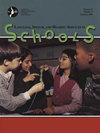Adverse Childhood Experiences, Intergenerational Trauma, and Historical Trauma: A Child's Story.
IF 2.9
3区 医学
Q1 AUDIOLOGY & SPEECH-LANGUAGE PATHOLOGY
Language Speech and Hearing Services in Schools
Pub Date : 2025-05-19
DOI:10.1044/2025_lshss-24-00123
引用次数: 0
Abstract
PURPOSE The prevalence of adverse childhood experiences (ACEs) is increasing and is highest in minoritized ethnic/racial groups, most notably in Indigenous populations in the United States and Canada. Beyond ACEs, minoritized ethnic/racial groups have also experienced historical oppression, discrimination, and economic inequalities that can perpetuate ACEs and initiate intergenerational cycles of adversity. Children who have experienced multiple ACEs are at risk for learning and communication impairments that would qualify them for speech and language services. The purpose of this case study is to: (a) define ACEs, intergenerational and historical trauma, as well as describe the causes, consequences, and relationships among these three types of trauma; (b) describe the use of the International Classification of Functioning, Disability and Health (ICF) for assessment of an Indigenous child who has experienced multiple ACEs that may be associated with historical trauma; and (c) describe implementation of the Attachment, Regulation, Competency intervention for children with complex posttraumatic stress disorder adapted for an Indigenous child. CONCLUSIONS The concept of historical trauma arose with Indigenous populations, but it has been extended to many other populations that have experienced chronic trauma associated with oppression based on their ethnicity, race, or culture. The ICF provides a framework for conducting a comprehensive assessment and developing an intervention plan for a child who has experienced multiple ACEs, possibly related to intergenerational and historical trauma. To understand the child's strengths and needs, it is essential that clinicians consider the child's unique personal and environmental contextual factors. By considering these contextual factors, clinicians can identify which attributes serve as barriers or facilitators to children's functioning and how intervention programs may need to be adapted for the child's culture.不良童年经历、代际创伤和历史创伤:一个孩子的故事。
目的不良童年经历(ace)的患病率正在上升,在少数民族/种族群体中最高,尤其是在美国和加拿大的土著人口中。除了ace,少数民族/种族群体也经历了历史上的压迫、歧视和经济不平等,这些都可能使ace永久化,并引发代际逆境循环。经历过多次ace的儿童有学习和沟通障碍的风险,这将使他们有资格获得言语和语言服务。本案例研究的目的是:(a)定义ace、代际创伤和历史创伤,并描述这三种创伤的原因、后果和关系;描述使用国际功能、残疾和健康分类(ICF)对可能与历史创伤有关的多次不良经历的土著儿童进行评估的情况;(c)描述适用于土著儿童的复杂创伤后应激障碍儿童的依恋、调节、能力干预的实施情况。历史创伤的概念起源于土著人口,但它已扩展到许多其他人口,这些人口经历了与基于其民族、种族或文化的压迫相关的慢性创伤。ICF提供了一个框架,用于对经历过多次ace(可能与代际和历史创伤有关)的儿童进行全面评估和制定干预计划。为了了解儿童的优势和需求,临床医生必须考虑儿童独特的个人和环境背景因素。通过考虑这些背景因素,临床医生可以确定哪些属性是儿童功能的障碍或促进因素,以及如何根据儿童的文化调整干预方案。
本文章由计算机程序翻译,如有差异,请以英文原文为准。
求助全文
约1分钟内获得全文
求助全文
来源期刊

Language Speech and Hearing Services in Schools
Social Sciences-Linguistics and Language
CiteScore
4.40
自引率
12.50%
发文量
165
期刊介绍:
Mission: LSHSS publishes peer-reviewed research and other scholarly articles pertaining to the practice of audiology and speech-language pathology in the schools, focusing on children and adolescents. The journal is an international outlet for clinical research and is designed to promote development and analysis of approaches concerning the delivery of services to the school-aged population. LSHSS seeks to advance evidence-based practice by disseminating the results of new studies as well as providing a forum for critical reviews and meta-analyses of previously published work.
Scope: The broad field of audiology and speech-language pathology as practiced in schools, including aural rehabilitation; augmentative and alternative communication; childhood apraxia of speech; classroom acoustics; cognitive impairment; craniofacial disorders; fluency disorders; hearing-assistive technology; language disorders; literacy disorders including reading, writing, and spelling; motor speech disorders; speech sound disorders; swallowing, dysphagia, and feeding disorders; voice disorders.
 求助内容:
求助内容: 应助结果提醒方式:
应助结果提醒方式:


